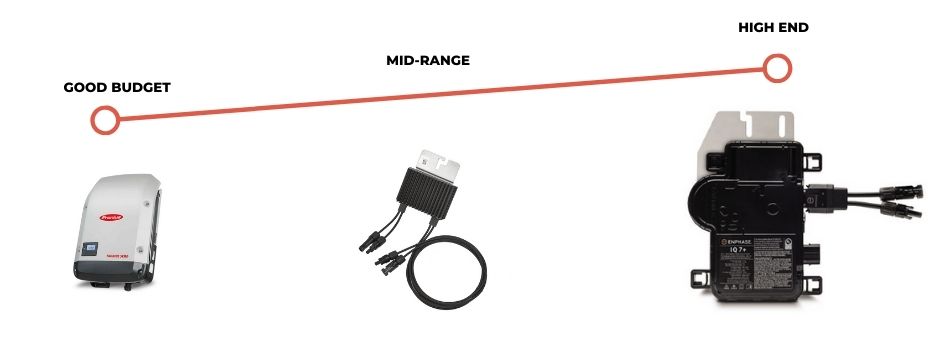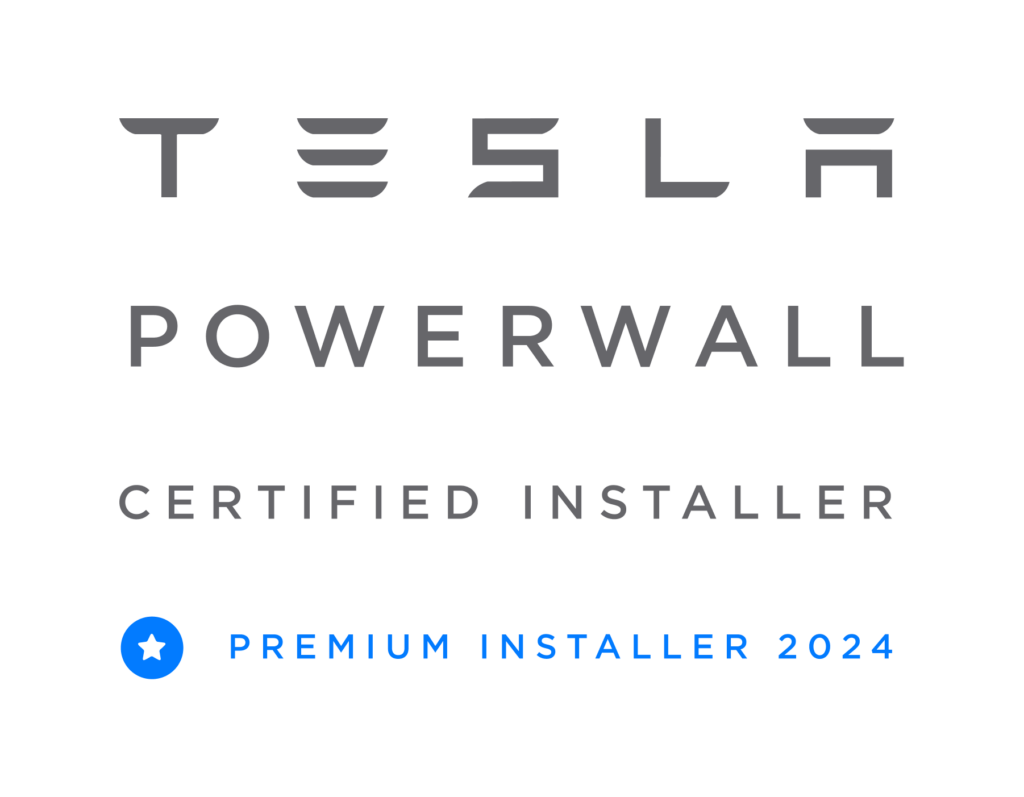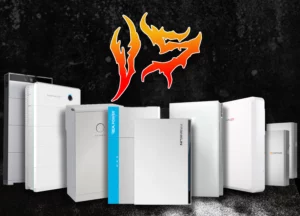Micro Inverter vs String Inverter vs Panel Optimisers
So it’s safe to say that you are most likely interested in a solar system since you’ve landed on this page. You are probably aware that there are 2 main components that make up your solar system. These are the solar panels, and the solar inverter.
What you may not know, is that there are a few different types of inverters. You have your common PV string inverter which is most popular in Australia due to its affordability.
Then you also have more advanced technology such as micro inverters or panel optimisers. So, which one is better you ask?
It’s tough to say, however I will be breaking it all down for you to understand which one is best for your home.
To give you a quick summary answer, micro inverter and power optimiser technology is far superior to string inverters and come with a huge range of extra benefits, you as the homeowner can take advantage of.
Each inverter is going to work differently for every homeowner, that is because each home and each person is different and wants to achieve something different from solar. Therefore, it’s not about which one is best on paper, it’s about which one is best for you.
So, let’s go through micro inverter vs string inverter vs panel optimisers and find out exactly which one is going to suit your home best.
If you are ready to start getting a solar design proposal, don’t hesitate to request one from my solar engineers here.
If you are interested in micro inverters, you should read more about them in our full Enphase micro inverter review guide. If you are ready to get a price for these, contact our Enphase designers here.
Same applies for SolarEdge panel optimisers. Please feel free to read our full review on SolarEdge power optimisers here. If you are looking for a price then request one from our SolarEdge design engineers here.
For string inverters we can help you choose the best one that’s suited for your home, usually it’s either the SunGrow SK series or the Fronius Symo or Primo or Gen 24.
Table Of Contents

What Is A Micro Inverter?
A micro-inverter is an inverter that fits directly to each solar panel in your system. By managing the AC conversion at each panel, micro-inverters can make your system more efficient and improve performance.
When sunlight hits the solar panel, the micro inverter will convert this energy into AC power directly at the solar panel which comes with a huge range of efficiency and safety benefits.
They also make solar panel systems safer through reducing the distance high-voltage currents have to travel. Micro-inverters also bring lots of other benefits, such as the ability to have more flexibility in the layout of your system.
This is because each solar panel can perform independently from the rest. When this happens, you can place panels in positions that can optimise for your energy usage and the time that you use your energy the most.
A good example of a popular micro inverter would be those manufactured by Enphase. These are some of the best in the industry.
What Is A String Inverter?
A string inverter is a PV inverter that allows panels to be wired together into a series or strings. They can feature multiple inputs, and DC is converted to AC in a single unit. They’re the most commonly used option for residential systems and are highly efficient (so long as there is zero shading).
Essentially how string inverters work is by converting the DC energy generated by your solar panels into AC energy which can get used in your home. This however requires string/cable runs from the panels to the inverter which carry DC energy across your home.
Being the most common inverter option, string inverters are manufactured by a variety of companies in the solar space. Fronius and Sungrow however take the lead here. Not only this, but string inverters are the most affordable out of all solar inverters available.
What Are Panel Optimisers?
Panel optimisers, or power optimisers, attach individually to panels and control their output. This can be helpful as it ensures that if one of the panels in a string are under-performing, the performance of the rest is not affected. Panel optimisers also optimise the DC energy produced by panels, allowing an inverter to better and more efficiently convert to AC energy.
So in the most simple terms, a panel optimiser controls the DC voltage going from the panel to the inverter. The panel optimisers are in place to ensure that the DC voltage doesn’t reach a dangerous level.
Each panel optimiser also gives the panel independence from the rest, similar to micro inverters. This allows the owner to have full visibility over their system and overcome design or shading issues.
Solaredge manufactures some of the best panel optimisers available.
MicroInverters vs String Inverter vs Panel Optimisers
String Inverters are the most common type of inverter used in solar energy systems. Generally on a residential system you will have one per installation. When there is no shade they’re very efficient.
Generally with a string inverter system, if one panel is shaded or suffers a decrease in performance, then all of the individual panels on the system will suffer. So, therefore they are not really ideal for those looking to maximise their energy production or those looking for ROI.
Micro-inverters on the other hand eliminate this problem through individual optimisation of panels – if one panel is shaded, the other panels are not affected as each one has its own (micro)inverter. Don’t worry, you can also achieve the same with panel optimisers as well.
Micro inverters let you keep adding panels to your system
One benefit micro-inverters have over string inverters and panel optimisers is that you can add additional AC solar panel units easily because they are independent of each other. This independence is really useful, as it also allows you to diagnose any faults you might encounter faster.
Micro-inverters can also increase the efficiency of your panels. They do this through determining each system’s optimal voltage, and producing maximum peak power voltage. Though it’s worth noting that panel optimisers also have the ability to do this as well, so it’s a close call.
Both micro inverters and panel optimisers increase performance
Both micro-inverters and power optimisers benefit the performance of solar panel systems that are set up on difficult roofs. They also both allow for monitoring of individual solar panels and their performance. This can seriously come in handy for homeowners to maintain your system and know your energy usage, production and return on investment.
Power optimisers however do not convert electricity like micro-inverters do. Instead they ‘condition’ the DC energy before sending it to a central inverter. They then send this DC energy to the inverter where the conversion to AC takes place.
This ‘conditioned’ DC energy is more efficiently converted into AC than ‘regular’ DC energy, leading to improved performance from the panels in the system. It means less energy is lost so there is a high efficiency rating. As suggested before, it also means your system is safer.
String inverter systems lack in a flexible design
For anyone who has a smaller, or unique shaped roof then going for a string system might prove difficult. This is because string inverters lack the flexible design you can get with panel optimisers or micro inverters.
This is because string inverters work in strings which mean they connect a row of panels using one string which then runs down to the inverter. Therefore, you need each panel to be next to each other to run in a successful string.
This is different from panel optimisers or micro inverters which allow for a very flexible design because each panel can perform independently from the rest. Therefore, you won’t need the panels to be in a regular string and can allow for solo panels to be placed in utilised spaces.
Micro-inverters also give you the additional benefit of easy future expansion, allowing you to add unlimited solar panels to your system, provided you have the space.

String Inverters Are The Most Affordable, But Panel Optimisers & MicroInverters Are More Advanced
String inverters are the standard in the solar energy market, and are definitely the most popular choice when it comes to residential homes. They’re the most affordable, but also the simplest. So, this means that if you are considering solar on a budget you might be best looking at string inverters.
To be honest, I’d say around 60% of homeowners go for string inverters however over the next few years I’d love to see that change. Sometimes going for the cheapest only has the benefit for those who are looking for quick savings.
Being the cheapest also means that the quality might not last as long. Now, this isn’t to say that string inverters don’t last as long but the warranties definitely paint a different picture compared to micro inverters or panel optimisers.
Whilst generally string inverters have high efficiency, they miss out on the benefits offered by panel optimisers and micro-inverters. Namely the benefits stemming from individualisation of panels in a system. This can give them a major disadvantage when it comes to non optimal conditions.
As I said before, both micro inverter and panel optimiser technology is much more advanced and therefore comes with a higher warranty, and high quality products. Of course, this technology hasn’t quite become as affordable as string inverters yet… But let’s see what the future holds!
Don’t forget, you can also take advantage of the solar panel rebates available in Queensland or the Solar Victoria program that helps reduce the upfront cost of solar for you.

MicroInverters & Panel Optimisers Are Safer Than String Inverters
Panel optimisers are generally safer than string inverters, as they are able to shutdown in just 100 milliseconds if something becomes faulty. At the very least, this massively reduces risk of damage to the whole system in case of a fault, and at best it could prevent fires occurring.
Now, your house is your biggest asset. There isn’t much point in risking a big fire when it could be prevented with this technology. The same applies for micro inverters. They convert energy into AC at the panel therefore have a very low risk of any fire on your roof.
String inverters require the DC energy to run through strings to the inverter where it is converted into AC energy. Now, the majority of the time this is safe. The only time it becomes unsafe is when you choose a shoddy, cheap solar installer that cuts corners. Make sure you know the difference between good and bad installers.
String Inverters Will Give You A Quicker Return On Investment...
Due to string inverters being the popular choice, they are more affordable to set up and will bring you a faster return on investment. Although the other options come with many benefits string inverters miss out on, panel optimisers and micro-inverters do require a little extra investment.
However, you will get a much bigger investment back from using panel optimisers or micro inverters. With string inverters, you’ll be looking at a quicker return on investment but it will definitely be much shorter.
I would also argue that the size of the return on investment would be much lower from string inverters because you are getting less energy over time and therefore less savings over time. So, overall you will end up with a quicker return on investment but you will get less and it won’t last as long.

Panel Optimisers & MicroInverters Have A Much Longer Warranty
One area in which string inverters fall short is that of warranties. Thanks to more advanced technology and better safety features, panel optimisers and micro-inverters have a longer warranty period.
Well, this is true in some cases. However, it’s not true in other cases. For power optimisers you will be getting a 25 year warranty product along with the 10 year warranty on the SolarEdge inverter.
With Micro inverters you only get the 25 year product warranty if you use Sunpower maxeon 5 solar panels which come built with Enphase micro inverters. For any other solar panel, you will get a standard 10 year product warranty.
For me, it does make sense to invest in a better solar panel like Sunpower that’s going to provide a higher, longer and bigger return on investment and get covered by a 25 year warranty.
So, if you compare that to the typical 10 year warranty of a string inverter, it’s easy to see why so many are now looking at adopting these newer technologies, even if they cost a bit more of an investment.
String inverters like Fronius come with a 5 + 5 year warranty as well as the Sungrow premium inverter.

Situations When A String Inverter Is Best…
A string inverter is probably best if you’re on a limited budget, or if fast ROI is your priority. For those of you who might be looking to sell your house in the future but want to start seeing some savings today.
To be honest, they are a fantastic option for all homeowners and best suited for anyone who really wants to take advantage of the sunshine that is free and available to us in Australia. Due to the system being very basic it’s great for all homeowners.
Don’t forget, string inverters are best used on simple or entry-level solar panel systems. It’s best for those homes where flexibility and the ability to expand your system are not priorities.
They would be an ideal, affordable option for say, someone who wanted a simple panel system to slash their energy bills.
Situations When MicroInverters Are Best…
MicroInverters are best if you’ve got a bit of extra money to invest in your system, as they’ll bring better optimisation and better safety. They are also fantastic options if your property is shaded in any capacity.
This is due to their ability to individually convert energy from each panel in your system. If flexibility is a priority to you, and you value the ability to potentially expand your system, micro-inverters also take the crown over string inverters.
Not only this, but micro inverters provide full visibility over your system meaning maintenance becomes easy. You can see if any panels are underperforming and get it fixed up straight away.
I’d say that micro inverters are best for those who are looking for a long lasting, high return on investment from your solar system. They are going to give you a totally optimised system and allow you to maximise your energy and savings long term.
Situations When Panel Optimisers Are Best…
I’d suggest using panel optimisers similar to micro inverters. If you are looking for full visibility over your system and increased performance then panel optimisers are perfect for you. Also, they come with a whopping 25 year warranty meaning the return on investing will be high, and long lasting.
Their price is mid-range, so they won’t be a huge investment but of course cost slightly more than string PV inverters. Don’t forget, power optimisers can also allow for a flexible design and overcome any shading issues.
The only real difference is that they don’t convert DC to AC at the panel, instead they condition it to run at a safe voltage to the inverter. They can also be attached to any different brand of solar panels and still maintain their 25 year warranty.
Conclusion:
To give you a completely honest answer, I’d always choose a micro inverter or panel optimiser over the string inverter unless I’m on a serious budget or deciding on moving house later on in the future.
The benefits that you get from this technology completely outweigh the more affordable price that comes with string inverters. Plus, they are much safer, and I don’t think you can put a price on safety since we regularly see homes catching on fire from bad solar panel installations.
Overall, micro inverters and power optimisers are going to maximise your system and get you much greater savings over a longer period of time. String inverters are really good for basic systems but if you’re looking for quality, then I’d choose the more advanced.
They are all a great choice but make sure that you are choosing the right one that is going to work best for your home. This will help you maximise your energy output and of course, give you much greater savings from solar… Making it much more worthwhile!
Let us know your thoughts in the comments below. We’d love for you to share your experiences with everyone. If you have any of these systems, share below if you think it’s worth it or not 😁.
Share With Your Friends!
Written By:
Luke Cove
Managing Director
Lightning Solar & Electrical












2 thoughts on “Micro Inverter vs String Inverter vs Panel Optimisers”
What about off the grid system? Would you recommend panel optimiser?
The only inverters that should be installed are stand alone types, so for a long grid outage, your expensive solar power plant keeps working !!! Or you loose internet, phone chargers, food in your fridge……what do expect will happen when 3 million installs in Australia fail when we get a cyber attack and the grid is down for several months ??
DISASTER !!!
Wake up Australia.